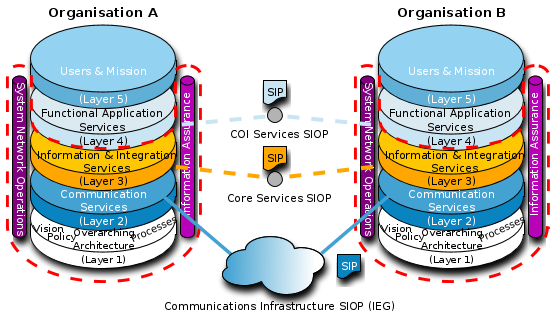2.5. Examples
213. The diagram below shows the concept of federated SOA using a simplified model with participants of Organization A and Organization B. Organizations are required to build SOA enterprise scale systems that conform to the NATO Overarching Architecture. The organizations' SOA are connected in a federated manner providing maximum scalability and interoperability.
214. The actual physical connection between the SOAs is at the communications layer. The point of interconnection is called the Service interoperability point (SIOP). The standards used to connect at the SIOP are documented in a Service interoperability profile or SIP.
215. There are also logical connections at the Core Services layer and COI Services layers. These connections also have associated SIPs.
216. An example of the Core Services SIOP is currently being investigated and demonstrated by UK MOD.[4]
217. There is also a logical connection at the COI Services layer. The ability to share COI services is where the main benefit is realized as these are the business services used to undertake missions. Using the guidelines outlined in this design rule, organizations can interoperate by sharing COI services to perform business tasks. For example the UK MOD SOA pilot project has demonstrated a "logistics demand service" which follows a business process to fulfill a request for a store item or spare part.
